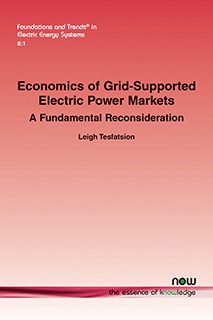Economics of Grid-Supported Electric Power Markets: A Fundamental Reconsideration
By Leigh Tesfatsion, Professor Emerita of Economics, Courtesy Research Professor of Electrical and Computer Engineering, Iowa State University, USA, tesfatsi@iastate.edu
Abstract
Centrally-managed U.S. wholesale power markets operating over high-voltage AC transmission grids are transitioning from heavy reliance on fossil-fuel based power to greater reliance on renewable power with increasingly diverse suppliers and customers. This study highlights four conceptually-problematic economic presumptions reflected in the legacy core design of these markets that are hindering this transition. The key problematic presumption is the static conceptualization of the basic product as grid-delivered energy (MWh) transacted in short-run (day-ahead and intra-day) markets at competitively determined unit prices ($/MWh), conditional on delivery location and time. This study argues, to the contrary, that the basic product in need of efficient reliable transaction in these markets is reserve (physically-covered insurance) for protection against power imbalance (volumetric grid risk). This reserve is the guaranteed availability of dispatchable nodal power-production capabilities for possible central dispatch during designated future operating periods at designated grid delivery locations to satisfy just-in-time customer power demands and grid reliability requirements. For illustration, a recently proposed Linked Swing-Contract Market Design is briefly reviewed. The latter design permits dispatchable power resources to offer diverse types of reserve into a centrally-managed collection of linked forward bid/offer-based reserve markets via two-part pricing insurance contracts taking a flexible swing form. The swing in these contracts permits efficient planning for real-time reliability, and the two-part pricing form of these contracts permits cleared suppliers to assure their revenue sufficiency. A principled cost allocation rule supports the independence of the fiducial central manager by assuring break-even revenue adequacy for system operations as a whole.
Economics of Grid-Supported Electric Power Markets: A Fundamental Reconsideration
Centrally-managed U.S. wholesale power markets operating over high-voltage AC transmission grids are transitioning from heavy reliance on fossil-fuel based power to greater reliance on renewable power with increasingly diverse suppliers and customers. This monograph highlights four conceptually-problematic economic presumptions reflected in the legacy core design of these markets that are hindering this transition. The key problematic presumption is the static conceptualization of the basic product as grid-delivered energy (MWh) transacted in short-run (day-ahead and intra-day) markets at competitively determined unit prices ($/MWh), conditional on delivery location and time. This study argues, to the contrary, that the basic product in need of efficient reliable transaction in these markets is reserve (physically covered insurance) for protection against power imbalance (volumetric grid risk).
This reserve is the guaranteed availability of dispatchable nodal power-production capabilities for possible central dispatch during designated future operating periods at designated grid delivery locations to satisfy just-in-time customer power demands and grid reliability requirements. For illustration, a recently proposed Linked Swing-Contract Market Design is briefly reviewed. The latter design permits dispatchable power resources to offer diverse types of reserve into a centrally-managed collection of linked forward bid/offer-based reserve markets via two-part pricing insurance contracts taking a flexible swing form. The swing in these contracts permits efficient planning for real-time reliability, and the two-part pricing form of these contracts permits cleared suppliers to assure their revenue sufficiency. A principled cost allocation rule supports the independence of the fiducial central manager by assuring break-even revenue adequacy for system operations as a whole.
